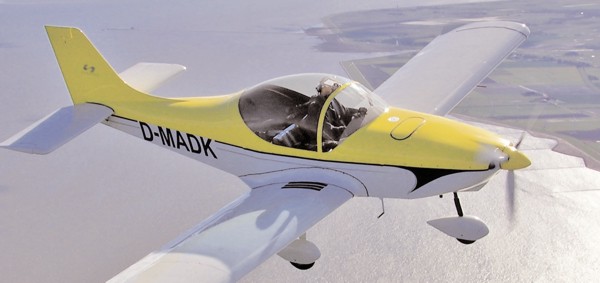
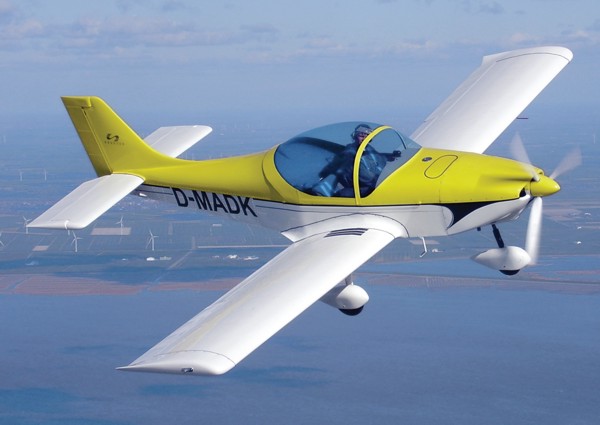
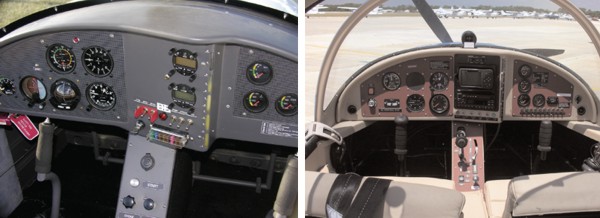
PANEL UPGRADE – The original Breezer (gray panel) was upgraded significantly to the new color and style-themed Breezer II (with color panel insets). Both
employ the angled radio stack section and the fuel quantity indicator (edge of angled panel).
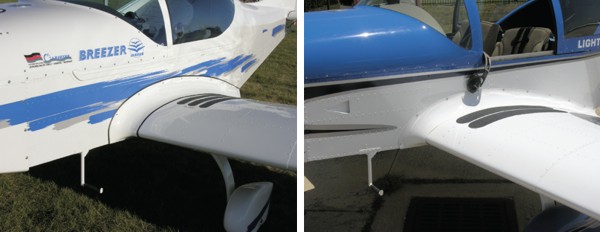
CLEANED-UP DESIGN – The Breezer II paint job is itself a nice enhancement, but the wing root is now cleaned up as part of the overall effort to upgrade the
design, which is now being manufactured by a new German entity, Breezer Aircraft.
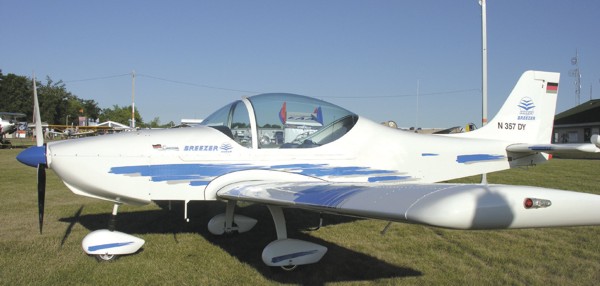
FIRST VIEWING – The original Breezer made its debut in the summer of 2005 after winning airworthiness as a Special Light-Sport Aircraft. While the basic
design remains the same, the new producer, Breezer Aircraft, has done good work to improve the airplane.

TOP GUNS – Mike Zidziunas, or simply “Mike Z” (seated), brought
the Breezer II with his student, Greg, from his home base at Plant
City airport in Central Florida. Mike runs Mike Z Sport Aviation
where Breezer II’s are assembled for customers.

INNER BREEZER – This tail cone view of the Breezer clearly reveals its all-metal construction.
What you cannot see is that all these surfaces come corrosion-proofed from the factory, which
should ensure a long life for the metal.

Mike Z Sport Aviation
Close to Perfect
It usually takes more than one
try to get something right. To
get close to a perfect aircraft
usually takes many iterations, but
Breezer Aircraft has come very close
to producing a wonderful light sport
aircraft with their Breezer II.
We’ve seen the Breezer before when
the U.S. importer brought the thennew
model to AirVenture Oshkosh
’05. I flew it that year and recently
got the chance to fly the Breezer II.
While many of the good qualities
found in the earlier model were
retained, some nice improvements
have been made. But it isn’t the airplane
that is the real story. As experienced
airplane buyers know, it is
often the company behind the airplane
that is the main story.
Breezer’s Brief Design History
The design history is brief because the Breezer
is a new aircraft, not seen before ’05 except during
its early development. That older, original Breezer
was produced under agreement by Comco-Ikarus,
the same folks that make one of Germany’s bestselling
ultralights (a different class than American
ultralights), the C-42.
U.S. distributor Sportsplanes.com first got
involved with the Breezer when it was produced
by Comco-Ikarus via an arrangement with Simon
Du Boulay, a UK-based agent for the German company.
However, beyond the reach of Sportsplanes.com
or Du Boulay, the agreement with Comco-Ikarus
fell into dispute and the production of the company
was halted. Using his handsome design,
designer Ralph Magnussen linked up with an
investor in Europe – a man involved with the
design and production of windmill power-generating
systems – who took over the production,
adding new equipment and quarters.
Now the airplane that rolls out of Breezer
Aircraft offers an improved finish and flies even
better. The aircraft are on a more orderly production,
reports the American importer,
Sportsplanes.com, and availability is better than
ever. Of course, like all aircraft valued in euros,
the sticker price is up substantially since ’05.
Unlike most aircraft crossing the Atlantic, the
Breezer II is an all-western-German design and
production. Most light sport aircraft come from
Eastern European countries, more often than not
the Czech Republic.
The Breezer fuselage and wings are made of
aluminum with the engine cowling, the upper part
of the fuselage, and the wingtips made of fiberglass.
Sportsplanes.com says all the bare metal
inside the airplane – including all those areas you
never see – have been corrosion-proofed.
A steerable nosewheel leads an undercarriage
made of thick fiberglass. Controls are conventional
3-axis employing flaps, ailerons, elevators, and
rudder.
As with most European suppliers, the Breezer is
powered by the 4-cylinder, 4-stroke, liquid-cooled
Rotax 912UL version producing 100 horsepower.
This firewall-forward package includes standard
Rotax electric
starter, electronic
dual ignition, stainless
steel exhaust
system with integrated
cabin heat,
integrated reduction
gearbox, and
carburetor preheating.
Basic equipment
includes a
Neuform groundadjustable,
2-blade,
carbon-fiber propeller
with fiberglass
spinner.
You enter the 46-
inch-wide cabin
after sliding the
canopy aft. The
Breezer shares
looks with many
low-wing airplanes, but it is an original design. I
found this out when I tried to enter the airplane.
Instead of the familiar trailing edge entry where I
try to avoid stepping on the flaps, I instead walked
toward the engine compartment. Here, in front of
the wing, I saw a peg step intended to help
entrants clamber over the leading edge. I liked it.
Your weight doesn’t tilt the plane aft and you have
the windscreen support to use for a handgrip.
With an aft-sliding canopy, the step design makes
sense. The only downside is that you must be certain
the engine has stopped before anyone exits
the Breezer II.
Once on the wing you step into the cockpit via
the seats, again like nearly all low-wing designs.
Using the seat back, you slide down into position.
A roomy cockpit aids egress and the front canopy
frame affords a sturdy grasp to help you up and
out. Despite these helpful qualities, even on this
new plane the floor carpeting had started to bunch
up from occupants pushing themselves back
against the seat as part of the exit effort.
The Breezer’s fuel system is as it was before, but
with that highly visible and very clear presentation
of remaining fuel. Fortunately, the Breezer II
shows quantity in gallons rather than liters as on
the original Breezer I flew.
Both airplanes offered a choke and fuel shut-off
but no carb heat, the common combination for
Rotax engines.
Elevator trim changed from a mechanical control
on the center console to a handier electric trim
atop the joystick, though its operation struck me
as counterintuitive. The front button raises the
nose and the rear button lowers it. I would prefer
it the other way.
The Breezer II’s flap control on the center console
is clearly labeled and an indicator appears
right alongside it. The flap button is unfortunately
almost flat so feeling its position isn’t automatic.
Plus, the flap indicator is upside down to my
reference; the top of the indicator composed of a
row of LED lights is labeled “Down” and the bottom
of the indicator is labeled “Up.” I got used to
it.
Up on a Breezer
Mike Zidziunas provided my flight (see sidebar,
“Mike Z Sport Aviation”). He’s become an expert
on the new Breezer and believes the next models
to come from Germany will have the flap indicator
up on the control panel so you don’t have to be
head-down to view the flap position. That will continue
a pattern of steady improvements of this
design.
Mike also observed that vernier throttles popular
on LSA use a screw method that can actually
damage throttle parts because it can exert a large
mechanical advantage not sensed by the pilot. You
could unscrew the throttle so far, Mike believes,
that you could shut the engine down, a fact that
might not be obvious on landing approach as the
prop could continue windmilling. This comment
may apply to any LSA that use such a throttle.
In my experience, when we pulled up to park, I
twirled back on the vernier and went far enough to
shut down the engine before I could reach the
usual switches.
The Breezer II’s interior was good, providing a fit
and finish that impressed Mike. I viewed it as a
notable improvement with a style and color theme
that made a good presentation compared to the
plainer earlier model. Being a Floridian, Mike had
installed some window sunscreens that helped
keep the heat off our heads.
The radio stack area was gently angled toward
the pilot. It was located on the copilot’s edge of that
angled section of panel that reveals the fuel quantity
indicator tube.
The Breezer II has a spacious hat rack area but
also a smaller locker aft of the seats that holds 44
pounds with tie-down straps, also available. The
design possesses enough useful load to benefit from
this baggage area.
The canopy slides aft and we taxied with it in
that position, a welcome quality for a low-wing airplane
being operated in a warm climate. A single
latch centered overhead secured the canopy in
flight.
Like other designs, the Breezer has dual joysticks
but the earlier design with its dual outside
throttles popular in Europe gave way to a more
common single center throttle with the vernier control.
The Breezer II’s instrument layout was composed
of conventional analog gauges . ASI,
rate of climb, tachometer, gyro, compass, sensitive
altimeter, and a slip indicator . all
mounted in front of the pilot. On the right
side were engine instruments for oil temperature,
water temperature, and cylinder heat
temperature. On its angled center panel, the
2008 Breezer II had an Air Gizmo dock holding
a Garmin GPS. Underneath was mounted
a conventional radio stack with radio and
transponder.
On a sloped center console, I discovered a
pivoting lever for the choke, a fuel shut-off
knob, and an electric flap switch. The older
Breezer had a trim knob that went to electric
operation mounted atop the Breezer II’s
control stick mounted.
The earlier Breezer used a centrally mounted
hand brake with a parking feature alongside the
since-replaced flap lever. The Breezer II went to
more conventional toe brakes that general aviation
pilots will love.
Easily seen yet subtly hidden was a fuel sight
gauge. Right where the angled panel steps back to
the engine gauges on the right is a rounded lip. At
this point, a clear tube was mounted behind a slotted
opening so that levels of fuel remaining can be
illustrated on the panel. The early Breezer showed
fuel quantity in liters; this has been changed to gallons
on the Breezer II for the American market.
Aft visibility was unusually good in the Breezer
II. I could see the rudder by turning slightly. By
turning more fully I could check traffic over a wide
area above the fuselage. Forward visibility was also
good, but naturally, the low wing prevents straight
down viewing.
When I flew the original Breezer, I found it a
most cooperative landing aircraft, which qualifies
it for training, especially given its good low-speed
characteristics. Nonetheless, the Breezer II is a
light airplane with light wing loading that could be
overcontroled.
Breezing Around
I learned about “overflying” the Breezer II during
landings. I tried to deep-flare the airplane when it
worked better to attitude-land it, letting the
Breezer II settle to the runway. When I used this
technique, I had wonderful landings that were
child’s play.
Beforehand, I held the nose too high, flying a bit
slowly. I had to concentrate to lower the nose to
maintain the correct approach speed. The Breezer
II does appear to have a good glide, but the view
over the nose causes some pilots to want to lift it.
I used 21.2 indicator bars to set flaps for landing,
at least with this particular Breezer II. I didn’t care
for the position of the flap indicator and I wished it
read the opposite way, but the LED bars are quick
to assess.
Though I never used them all for landing, I did
deploy full flaps to 45 degrees aloft and performed slow
flight. It went well and the Breezer II flew very
slowly, hanging easily on the edge of stall with an
absurdly low airspeed reading. Mike pointed out
that with flaps that low, the Breezer II shakes
around and lets you know you have an unusual
configuration set.
The Breezer’s slow-speed characteristics were
quite impressive. When we maximized the exercise
at a safe altitude, the airspeed indicator read below
30 mph indicated. At such slow speeds and high
angles of attack, instruments give erroneous readings.
But I could sense the slow movement through
wind noise. I needed a little more rudder to enter
turns at slow speeds, but the controls remained
quite effective.
Overall, the Breezer largely handles via the joystick.
Rudder pedals needed very little input to
make coordinated turns, but neither can you ignore
their operation.
The Breezer II does not automatically resume
straight flight. You must apply action to the rudder
pedals to straighten the airplane. No return
springs are used to help center the controls.
Mike, a longtime Avid Aircraft pilot, says he
takes corrective action without even thinking
about it, but a general aviation pilot with
all his or her experience in a Cessna 172
would have to learn this control technique.
Stick pressures were good, not particularly
light but very solid and predictable. Through
maneuvers like the Dutch roll coordination
exercise done at slow speeds, I found the
stick range was slightly limited by our legs
and outside aircraft structure, though this
would rarely be experienced in normal flying.
The Breezer II had a good roll rate and the
breakout forces were light.
Mike has observed that most general aviation pilots
tend to “overfly” the Breezer II, that is,
they use more coarse control input and don’t use a
light enough touch. Instead, he indicated, they
should just let the airplane “have his head” more.
When I followed Mike’s advice, things went swimmingly;
it pays to listen to your instructor.
General aviation pilots accustomed to flying
heavier airplanes that don’t respond as quickly get
more of a heavy hand on the controls and this
works against them in light sport aircraft.
Overall, the Breezer was very stable and felt
quite solid, a joy to fly. I could detect no oil canning
in its metal wing surfaces.
Like a number of LSA, the Breezer is genuinely
lightweight, yet can carry a load. Even loaded with
full fuel (18.5 gallons), the Breezer can haul two
225-pound occupants plus 50 pounds of luggage.
With full fuel, the Breezer can carry this payload
for longer than 3 hours and some 400 statute miles.
Running Swifter
Mike feels sure the Breezer II flies a bit faster,
though he hasn’t yet found the reason why. The
earlier Breezer I flew managed 105 knots at about
5,000 rpm where this Breezer II ran 115 knots at
5,200 rpm on the 100-hp Rotax 912S. Mike speculated
the earlier Breezer might have been slightly
out of rig. His memory is good; my notes reflected
that as well.
Climb was strong, better than 1,000 fpm. This
performance gave the feeling that Breezer II was
“athletic.” Its 18 gallons of fuel produced a 300-mile
range, says Mike. That’s all I need, though some
pilots hanker for longer, bladder-challenging distances.
During the high power running at lower elevations,
all the engine instruments read below green
or in the lower green range, speaking well of engine
compartment cooling.
When throttling back for slow flight, I was
amazed that at a 3,500-rpm power setting we could
nearly maintain altitude.
Steep turns went well to the right in that I was
able to hold altitude at only 4,000 rpm, which is a
medium setting and definitely not the added throttle
over cruise power most general aviation planes
seem to require to maintain altitude while banked
at 45° to 60°. Steep turns done to the left required
a slight addition of power.
The original Breezer had been equipped with a
ballistic parachute system; the Breezer II was not.
I missed this emergency device that is common on
LSA. Curiously, previous Breezer producer Comco-
Ikarus once developed their own Ikarus FRS
(Flight Rescue System) and offered the system
back in ’82, the same year American builder BRS
delivered its first units.
Stalls in the Breezer II produced a little break,
but controlling it took modest effort and no added
power was needed to recover quickly. The airplane
wandered somewhat at stall. Both power-on and
power-off stalls were modest and slow, reading well
below 40 mph indicated though, as usual, airspeeds
in this low range are often slightly in error.
Accelerated stalls to the left rolled to level. To the
right, the Breezer II did not roll to level and
required some control application to recover.
When I performed a yaw stability check with
firm application of rudder and release, the Breezer
II did not automatically resume straight flight. I
had to apply action to the rudder pedals to
straighten the airplane. At one point, without such
corrective action, I found myself flying along with
the slip-skid ball well outside of center.
Cruise power stalls done at 5,000 rpm got mushy
with the nose held high, but the nose showed no
tendency to break over.
Throughout the stalls, steep turns and fast runs, I heard
no creaking in the airframe. The Breezer II’s
overall polite behavior reinforced the trainer capability
of this reasonably speedy airplane.
Stir Up a Breezer?
My flight with Mike was in N304WS, which he
indicated is priced at $126,000 equipped with the
Garmin SL40, the Garmin GTX 327 transponder, and
the Air Gizmo Garmin GPS dock (but not the Garmin
GPS). The blank spot in my panel photos
will later be fitted with an optional
TruTrak artificial horizon, says Mike.
Mike also reported that the producers
in Germany have been very good to
work with and they make changes
quickly. He also stated that Breezer
Aircraft has shipped planes according
to schedule so far. Indeed,
Sportsplanes.com has Breezer II’s in
stock as this issue goes to press.
For the Breezer II’s base price you
get quite a finished aircraft. Standard
equipment includes upholstery for the
seats, cockpit and luggage area made
of quality textiles and a blue-tinted
lockable canopy with fresh-air inlets
on the left and right. Cabin heating is
standard, as are hydraulic disk toe
brakes plus electric elevator trim and
flaps. Flight instruments include
altimeter, airspeed indicator, compass,
vertical speed indicator,
and bank indicator.
Engine instruments
include a tachometer, oil
pressure indicator, cylinder
head temperature
gauge, oil temperature
gauge, and a sight fuel
gauge mounted in the
instrument panel.
Creature comforts include a 12-volt outlet
and luggage area behind the seats.
Supplied by a new and well-equipped
factory, the Breezer II enjoys quality
control based on work done completely
in Germany. The model has earned its
Special Light-Sport Aircraft (SLSA) certificate
and proved its good manners to
me, twice. But the only way for you to
know if the Breezer II is right for you is
to fly it and talk to the
Sportsplanes.com folks representing it in the USA.
One of their 15 regional centers can probably
arrange a demo flight for you soon. Go enjoy the
Breezer II.
| Seating | 2 side-by-side |
| Empty weight | 704 pounds |
| Gross weight | 1,320 pounds |
| Wingspan | 28.5 feet |
| Wing area | 127 square feet |
| Wing loading | 10.4 pounds/square foot |
| Useful Load | 616 pounds |
| Length | 21 feet |
| Payload (with full fuel) | 505 pounds |
| Cabin Interior | 46 inches |
| Height | 6.9 feet |
| Fuel Capacity | 18.5 gallons |
| Baggage area | 44 pounds, aft of seats |
| Airworthiness | Certified SLSA |
| Standard engine | Rotax 912 UL2/ULS2 |
| Prop Diameter | two- or three-blade Neuform |
| Power | 80-100 hp |
| Power loading | 13.2 pounds/hp |
| Max Speed | 120 knots/138 mph |
| Cruise speed | 109 knots/125/mph |
| Stall Speed | 36 knots/41 mph |
| Never exceed speed | 133 knots/153 mph |
| Rate of climb at gross | 1,100 fpm |
| Takeoff distance at gross | 440 feet (80hp)/310 feet (100hp) |
| Landing distance at gross | 455 feet |
| Range (powered) | 350 nm – 4.0 hours |
| Fuel Consumption | about 5.0 gph |
| Standard Features | Rotax 912 with electric start, basic panel instruments, familiar all-metal construction, sliding canopy, hydraulic toe brakes, adjustable seats, electric flaps and pitch trim, dual controls, 4-point seat belts, cabin heating, ventilation, baggage area. |
| Options | Numerous additional instrumentation, including glass displays, radio choices, autopilot, IFR instrumentation, ballistic parachute, lighting packages. |
| Construction | Aluminum airframe, fiberglass fairing components, all-aluminum wing and tail skins and fuselage. Made in (formerly West) Germany; distributed by an U.S.-based company with American dealers. |
Design
Cosmetic appearance, structural integrity, achievement of design goals, effectiveness of aerodynamics, ergonomics.
Pros – Redone, improved design in its second
generation, now supplied by a well-financed manufacturer.
All-metal design with an attractive shape.
New features address the U.S. market well (toe
brakes, for example). Good payload, able to carry
two rather large occupants plus baggage.
Cons – Earlier problems with the supplier of
the older Breezer model may have tainted some
resale buyer opinions. Even without the history,
the Breezer is not well known in America yet;
building name recognition takes time and good
results, all yet to be determined.
Systems
Subsystems available to pilot such as: Flaps; Fuel sources; Electric start; In-air restart; Brakes; Engine controls; Navigations; Radio; (items covered may be optional).
Pros – Fully equipped Breezer II features nice
improvements over the first model brought to the
USA. Trim and flaps are now electric; trim is on
the joystick for easy access. Legions of pilots
unused to hand brake arrangements will welcome
toe brakes.
Cons – Flap indicator is in a poor position,
resulting in a head-down pilot at a time when he or
she needs to be observing landing approach or
departure. Flap switch is too flat to tell its position
without looking. Some pilots won’t consider the
18.5-gallon capacity to be sufficient.
Cockpit/Cabin
Instrumentation; Ergonomics of controls; Creature comforts; (items covered may be optional).
Pros – Spacious 46-inch-wide cockpit will
accommodate all but the very largest occupants.
Entry over the leading edge, thanks to a well-located
entry peg/step, is better than the more common
step-over-the-flap entry. Large hat rack can be
reached in flight. Good instrument panel space
available.
Cons – Like many low-wing designs, you must
step on the seat for entry and must push yourself
back up for exit (caused carpet bunching even on a
new test aircraft). Sliding canopies have some
quick-exit vulnerability in landing upsets.
Ground Handling
Taxi visibility; Steering; Turn radius; Shock absorption; Stance/Stability; Braking.
Pros – All general aviation pilots will love the
new toe brakes, which worked very well. Visibility
was excellent, even to the rear as you are doing
control checks. Gear absorbed bumps well. Turn
radius was fairly small and can be aided with differential
braking.
Cons – Low-wing airplanes are not considered
particularly versatile on uneven, unimproved strips
due to wing clearance. Quick exit out of the
Breezer II is not as fast as some designs (you must
lift yourself up and out). No other negatives.
Takeoff/Landing
Qualities; Efficiency; Ease; Comparative values.
Pros – Easy-landing design (when you follow
instructions and let the plane have its own head).
Superb visibility for takeoffs and landings; good
traffic check capability and low nose on landing
gave a wide-open view. Flaps were quite effective.
Low-speed capability made for low landing speeds
and easy touchdowns.
Cons – You can (I did) “overfly” the Breezer II
on landings; it prefers an attitude approach to a
deep flare (which I almost always attempt), somewhat
unusual for an airplane with light wing loading.
Slips were workable, but I did not find them
highly effective (though good flaps obviate the need
for slipping).
Control
Quality and quantity for: Coordination; Authority; Pressures; Response; and Coupling.
Pros – Quality controls with good response yet
without twitchy action; new pilots and students
should like the Breezer II handling. Easy stick
reach and response; most pilots will find controls
comfortable. Steep turns held a good circle easily
without adding power.
Cons – You must use the rudder pedals for
coordinated turns and you must return them to
neutral by pilot input; didn’t return aerodynamically
in evaluation.
Performance
Climb; Glide; Sink; Cruise/stall/max speeds; Endurance; Range; Maneuverability.
Pros – Excellent climb performance. Glide also
seemed strong, helping make easy approaches to
landing. Speed showed enhancements from earlier
model to the Breezer II with cruise at 115 knots at
5,200 rpm (though earlier model may have suffered
from rigging errors). Excellent slow-flying qualities.
Cons – Fuel capacity at 18.5 gallons only yields
a 300-nm range, insufficient to please all pilots.
Not quite the fastest among LSA (though only marginally
below the top performers).
Stability
Stall recovery and characteristics; Dampening; Spiral stability; Adverse yaw qualities.
Pros – No stalls exhibited any deep nose
break. All stability checks showed a well-considered
design (see “Cons” for rudder response). Power
response and longitudinal checks proved a stable
flying design. Steep turns maintained altitude with
no power added.
Cons – Rudder pedals required that I move
them in the desired direction. The Breezer II will
not automatically return to straight flight after
rudder deflection; it’s easy but you must do it. No
parachute fitted to this evaluation Breezer II, so no
unusual attitudes explored.
Overall
Addresses the questions: “Will a buyer get what he/she expects to buy, and did the designer/builder achieve the chosen goal?”
Pros – New producer gives this quality design
new importance in the market. Good improvements
made to better fit the American market. Tasteful
color and style themed interior treatment will
please resale buyers. Experienced importer with 15
regional outlets across the country.
Cons – Few Breezers flying in the USA, making
resale value unknown. Change of producers
may cause some buyers to wait for more experience.
Some pilots living in warm, sunny climates
don’t desire low-wing, bubble canopy designs.
Supply of parts and repair expertise is still growing.


Leave a Reply